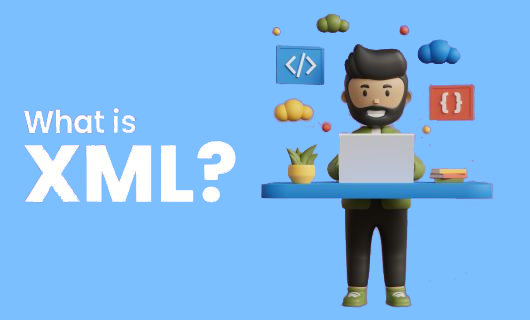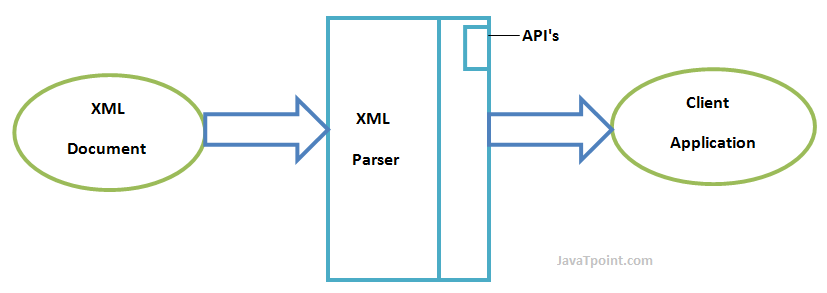Fundamental Tutorials of XML
What is XML?

XML (eXtensible Markup Language) is a markup language used for structuring and representing data in a hierarchical and human-readable format. It is designed to be both machine-readable and easily understandable by humans, making it a versatile format for data interchange and storage. XML does not define any specific tags or elements; instead, it provides a framework for creating custom tags that suit the needs of different applications.
Here are some of the most common uses of XML:
- Data storage: XML can be used to store data in a structured format. This makes it easy to store and transport data, and it also makes it easy to search and parse data.
- Web services: XML is often used to create web services. Web services are remote applications that can be accessed over the Internet. XML is a good choice for web services because it is a standard format that can be understood by different applications.
- Configuration files: XML is often used to create configuration files. Configuration files are used to store the settings for applications and devices. XML is a good choice for configuration files because it is a human-readable format that can be easily edited.
- Document formats: XML can be used to create document formats. Document formats are used to store documents in a structured format. This makes it easy to exchange documents between different applications.
What is top use cases of XML?
Here are some of the top use cases of XML:
- Data storage: XML is often used to store data in a structured format. This makes it easy to store and transport data, and it also makes it easy to search and parse data. For example, XML is used to store product data in e-commerce websites.
- Web services: XML is often used to create web services. Web services are remote applications that can be accessed over the Internet. XML is a good choice for web services because it is a standard format that can be understood by different applications. For example, XML is used to create the Google Maps API.
- Configuration files: XML is often used to create configuration files. Configuration files are used to store the settings for applications and devices. XML is a good choice for configuration files because it is a human-readable format that can be easily edited. For example, XML is used to create the Windows Registry.
- Document formats: XML can be used to create document formats. Document formats are used to store documents in a structured format. This makes it easy to exchange documents between different applications. For example, XML is used to create the OpenDocument format.
- RSS and Atom feed: XML is often used to create RSS and Atom feeds. RSS and Atom feeds are used to distribute content, such as news articles and blog posts. For example, XML is used to create the BBC News RSS feed.
- E-commerce: XML is often used in e-commerce websites to store product data. For example, Amazon uses XML to store product data on its website.
- Government: XML is often used by governments to store and exchange data. For example, the United States government uses XML to store weather data.
- Mapping: XML is often used in mapping applications to store geographical data. For example, Google Maps uses XML to store geographical data.
- Scientific research: XML is often used in scientific research to store and exchange data. For example, the Protein Data Bank uses XML to store protein data.
What are the features of XML?
Here are some of the features of XML:
- Data portability: XML is a standard format that can be understood by different applications. This makes it easy to store and transport data between different applications.
- Data validation: XML can be used to validate data. This means that you can ensure that the data in an XML file is valid before you use it.
- Data searchability: XML files are human-readable and can be easily searched. This makes it easy to find the data that you need in an XML file.
- Extensibility: XML is an extensible language. This means that you can create your own XML tags to store data in a way that is specific to your needs.
- Self-describing: XML documents are self-describing, which means that they contain all of the information that is needed to understand them. This makes it easy to use XML documents without having to know the underlying XML syntax.
- Platform-independent: XML is a platform-independent language, which means that it can be used on any platform. This makes it a good choice for storing and transporting data between different platforms.
- Efficient: XML is an efficient language for storing and transporting data. This is because XML files are typically much smaller than binary files.
- Secure: XML is a secure language for storing and transporting data. This is because XML files can be encrypted to protect them from unauthorized access.
What is the workflow of XML?
The workflow of XML is as follows:
- Create an XML document: You can create an XML document using a text editor or a dedicated XML editor.
- Validate the XML document: You can validate the XML document to ensure that it is well-formed and that it conforms to the XML schema.
- Process the XML document: You can process the XML document using an XML parser. An XML parser is a program that reads XML documents and converts them into data structures that can be used by other programs.
- Store the XML document: You can store the XML document in a file or in a database.
- Transmit the XML document: You can transmit the XML document over the internet or over a local network.
How XML Works & Architecture?

XML (eXtensible Markup Language) works by providing a structured way to represent data in a human-readable and machine-readable format. It uses a set of rules and conventions for defining elements, attributes, and their relationships within a document. Here’s an overview of how XML works and its architecture:
- Document Structure:
XML documents are composed of elements enclosed in tags. Tags are denoted by angle brackets (< and >) and define the beginning and end of elements. Elements can have attributes and contain other elements or text content.
- Hierarchical Nature:
XML documents have a hierarchical structure, forming a tree-like organization of elements. Each element can have parent and child elements, creating a parent-child relationship. This hierarchy allows data to be organized in a structured manner.
- Tags and Elements:
Tags represent the opening and closing of elements. An opening tag indicates the start of an element, while a closing tag indicates the end of the element. The content between the tags can include text, other elements, or a combination of both.
- Attributes:
Elements can have attributes, which provide additional information about the element. Attributes are specified within the opening tag and have a name-value pair format. For example: .
- XML Declaration:
An XML declaration appears at the beginning of the document and specifies the version of XML being used and the character encoding.
- Document Type Definition (DTD) or XML Schema:
XML documents can be associated with a Document Type Definition (DTD) or an XML Schema. These specifications define the structure, rules, and data types that the XML document must adhere to. DTDs and schemas provide a formal way to validate XML documents.
- Processing Instructions:
XML documents can include processing instructions that provide directives for applications processing the document. Processing instructions are enclosed within.
- Namespaces:
XML namespaces allow elements and attributes to be uniquely identified, even if they have the same names. Namespaces are declared using attributes like xmlns and help avoid naming conflicts in XML documents.
- CDATA Sections:
CDATA (Character Data) sections allow you to include raw text that should not be parsed as XML. This is useful when you want to include special characters or code snippets within XML content.
- Transformation with XSLT:
- XML documents can be transformed into other formats using XSLT (eXtensible Stylesheet Language Transformations). XSLT enables you to define rules for converting XML data into HTML, plain text, or other structured formats.
How to Install and Configure XML?
There are a few different ways to install and configure XML. Here are two common methods:
Using a package manager: If you are using a Linux distribution, you can install XML using a package manager, such as apt-get or yum. For example, to install XML on Ubuntu, you would run the following command:
sudo apt-get install libxml2-devOnce XML is installed, you can configure it by editing the /etc/xml/config.xml file. This file contains the default settings for XML.
Using a binary distribution: You can also install XML using a binary distribution. There are a number of different binary distributions available, such as the libxml2 library and the Xerces-C++ library. Once you have downloaded a binary distribution, you can install it by following the instructions in the distribution’s documentation.
Once XML is installed, you can start creating and using XML documents. You can use a text editor to create XML documents, or you can use a dedicated XML editor, such as XMLSpy or Oxygen XML Editor.
To learn more about XML, you can refer to the following resources:
- The XML tutorial: https://www.w3schools.com/xml/default.asp
- The XML specification: https://www.w3.org/TR/xml/
- The libxml2 library: https://www.xmlsoft.org/
- The Xerces-C++ library: https://xerces.apache.org/